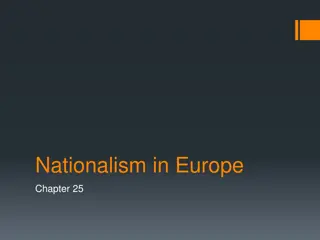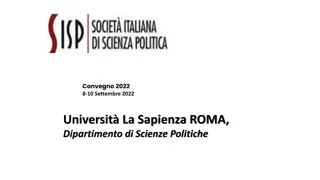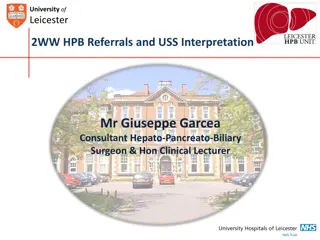
Strengthening Financial Stability Architecture Through EU Regulatory Framework
Explore the updated core principles discussed at the IADI Annual Conference in 2014, focusing on DGS funding and mandate to enhance the financial stability architecture within the EU regulatory framework. The conference delved into key aspects such as banking crises management, the Banking Union, single rule book, and deposit guarantee systems in the new framework. Learn about core principles, EU directives, and the comprehensive regulatory measures aimed at fortifying financial stability in the banking sector.
Download Presentation

Please find below an Image/Link to download the presentation.
The content on the website is provided AS IS for your information and personal use only. It may not be sold, licensed, or shared on other websites without obtaining consent from the author. If you encounter any issues during the download, it is possible that the publisher has removed the file from their server.
You are allowed to download the files provided on this website for personal or commercial use, subject to the condition that they are used lawfully. All files are the property of their respective owners.
The content on the website is provided AS IS for your information and personal use only. It may not be sold, licensed, or shared on other websites without obtaining consent from the author.
E N D
Presentation Transcript
IADI Annual Conference Updated Core Principles to strengthen the Financial Stability Architecture The EU regulatory framework: DGS funding and mandate Giuseppe Boccuzzi FITD Director General 22 October 2014
Agenda The EU regulatory framework: an overview Core principles and EU directives o DGS funding o DGS mandate Financing resolution
The EU regulatory framework and the financial crisis: a new approach for managing banking crises From minimum harmonisation to a wider convergence Financial crisis Directive 2014/49/UE on DGS Directive 94/19/CE on DGS Directive 2014/59/UE on bank recovery and resolution Directive 2001/24/CE on the reorganisation and winding up of credit institutions
The final step: Banking Union ESM (European Stability Mechanism) direct recapitalization of troubled banks after 4 Nov 2014 A new institutional set-up Single Supervisory Mechanism SSM Single Resolution Mechanism SRM Banking Union Single DGS Single Rulebook Harmonised network of DGSs
Banking Union: the Single Rule book A comprehensive set of common rules SSM Regulation Framework Regulation CRR e CRD IV (Basel 3) Supervisory Manual BRRD SRM Regulation DGSD ITS & RTS EBA EU Commission delegated acts
Deposit guarantee in the new framework: key questions The objectives of a DGS are to enhance confidence and contribute to financial stability. Why? 1 DGSs are essential components of the financial safety net. Who? Banks private investors and the banking system. 2 Insolvency or before insolvency? It depends on the DGs mandate: from a pure pay-box to a risk minimiser When? 3 The solution of a bank crisis requires financial resources in different forms: capital, guarantees, financial support, depositors pay-out. How? 4 EU responses Global responses FSB EC ECB NCA EBA BCBS
Core Principles and the EU regulatory framework Principles and guidance addressed to DGS and policy makers CPs Broader in scope and applicable at a global level (IMF FSAP) should document Prescriptive rules addressed to EU member States, the DGSs and their member banks, to be transposed into national legislation EU Directives shall document
DGS sources and use of funds in the Core Principles (CP9) and DGSD readily available funds and all funding mechanisms necessary to ensure prompt reimbursement of depositors claims, including assured liquidity funding arrangements. DGSD Ex-ante Fund target size ex-ante contributions - target of at least 0.8% of total covered deposits in 10 years extraordinary contributions - ex-post (up to 0.5% of total covered deposits per year) Funding agreements with the Central bank, the Government and market borrowing Emerging funding arrangements Alternative funding arrangements (short- term), e.g. market and central bank loans Voluntary mutual borrowing among EU DGS Substantially equivalent contributions proportional to the risk of the members and taking into due account the risk profiles of the various business models and balance sheet and risk indicators, such as capital adequacy, asset quality and liquidity Differential premiums EBA Guidelines
DGS mandate in CP2 and in Directive 2014/49/EU (Art. 10) Paragraph 1 repay depositors; Pay-box Paragraph 2 finance the resolution Paragraph 3 for alternative measures to prevent the failure; Pay-box plus Paragraph 6 to finance measures to preserve the access of depositors to covered deposits, including transfer of assets and liabilities and deposit book transfer, in the context of national insolvency proceedings, provided that the costs borne by the DGS do not exceed the net amount for compensating covered depositors. Loss minimiser Risk minimiser DGSD - art. 11 Use of funds
Financing resolution in the EU framework Resolution procedure Private resources Mandatory residual contribution Bail-in Resolution funds DGSs Art. 11 (2) DGSD: mandatory DGS contribution in resolution Condition: bail-in at least equal to 8% of total liabilities Limit: up to 5% of total liabilities Art. 109 BRRD: use of the DGS in the context of resolution cash contribution as a loss absorber taking the place of covered depositors Art. 108 BRRD: depositor preference
DGS role in financing resolution: conditions (1/3) CP9 DGSD & BRRD Mandatory use of DGS funds in resolution: Where the deposit insurer is not the resolution authority, it has the option, within its legal framework, to authorise the use of its funds for resolution of member institutions other than liquidation. The financial means of DGS shall be used in order to finance the resolution of credit institutions in accordance with article 109 of BRRD. The Resolution Authority shall determine, after consulting the DGS, the amount by which the DGS is liable (art. 11 (2) DGSD). In such situations the following conditions are met: Recital 51: Competent authorities, designated authorities, resolution authorities, relevant administrative authorities and DGSs should cooperate with each other. They should cooperate from an early stage in the preparation and implementation of the resolution measures( ). (a) the deposit insurer is informed and involved in the resolution decision-making process; (b) the use of the deposit insurer s funds is transparent and documented and is clearly and formally specified; Art. 4 (10): Member States shall ensure that the DGSs are informed as soon as possible in the event that ( ) a bank and the intervention of the DGS becomes likely.
DGS role in financing resolution: conditions (2/3) CP9 DGSD & BRRD Art. 109 (1) BRRD: ( ) the DGS to which the institution is affiliated is liable for the amount of losses that covered depositors would have suffered, had covered depositors be exposed to losses in the application of resolution tools. (c) where a bank is resolved through a resolution process other than liquidation, the resolution results in a viable, solvent and restructured bank, which limits the exposure of the deposit insurer to contribute additional funding in respect of the same obligation; Art. 108 BRRD: depositor preference The DGS is a loss absorber on behalf of covered depositors (virtual bail-in of the DGS). Residual contribution to resolution
DGS role in financing resolution: conditions (3/3) CP9 DGSD & BRRD Art. 109 (1) BRRD: In all cases, the liability of the DGS shall not be greater than the amount of losses that it would have had to bear had the institution been wound up under normal insolvency proceedings (no creditor worse-off). (d) contributions are restricted to the costs the deposit insurer would otherwise have incurred in a payout of insured depositors in a liquidation net of expected recoveries; (e) contributions are not used for the recapitalisation of resolved institutions; When the bail-in tool is applied, the DGS shall not be required to make any contribution towards the costs of recapitalising the bank or bridge-bank. (f) the use of the deposit insurer s funds is subject to an independent audit and the results reported back to the deposit insurer; and Valuation of difference in treatment as per Art. 74 BRRD. Art. 75 BRRD: in case the DGS has incurred greater losses than it would have incurred in a winding up under normal insolvency proceedings, the DGS is entitled to the payment of the difference from the resolution financing arrangements. (g) all resolution actions and decisions using the deposit insurer s funds are subject to ex-post review.
Financing resolution: critical issues In the design of the EU regulatory framework DGSs are at a national level In the EU member States that are participating in the SSM-SRM, DGS is national and the RF will be the SRF In the EU member States that are not participating in the SSM-SRM, the DGS and the RF are both national and may be managed by the same institution EU members in the Banking Union Two different levels: EU members not in the Banking Union
Way forward Should DGSs remain national or shift to a single system? How should the DGS interact with the centralised resolution authority? What will the role of the DGS be in the future? The role of deposit insurers international associations














